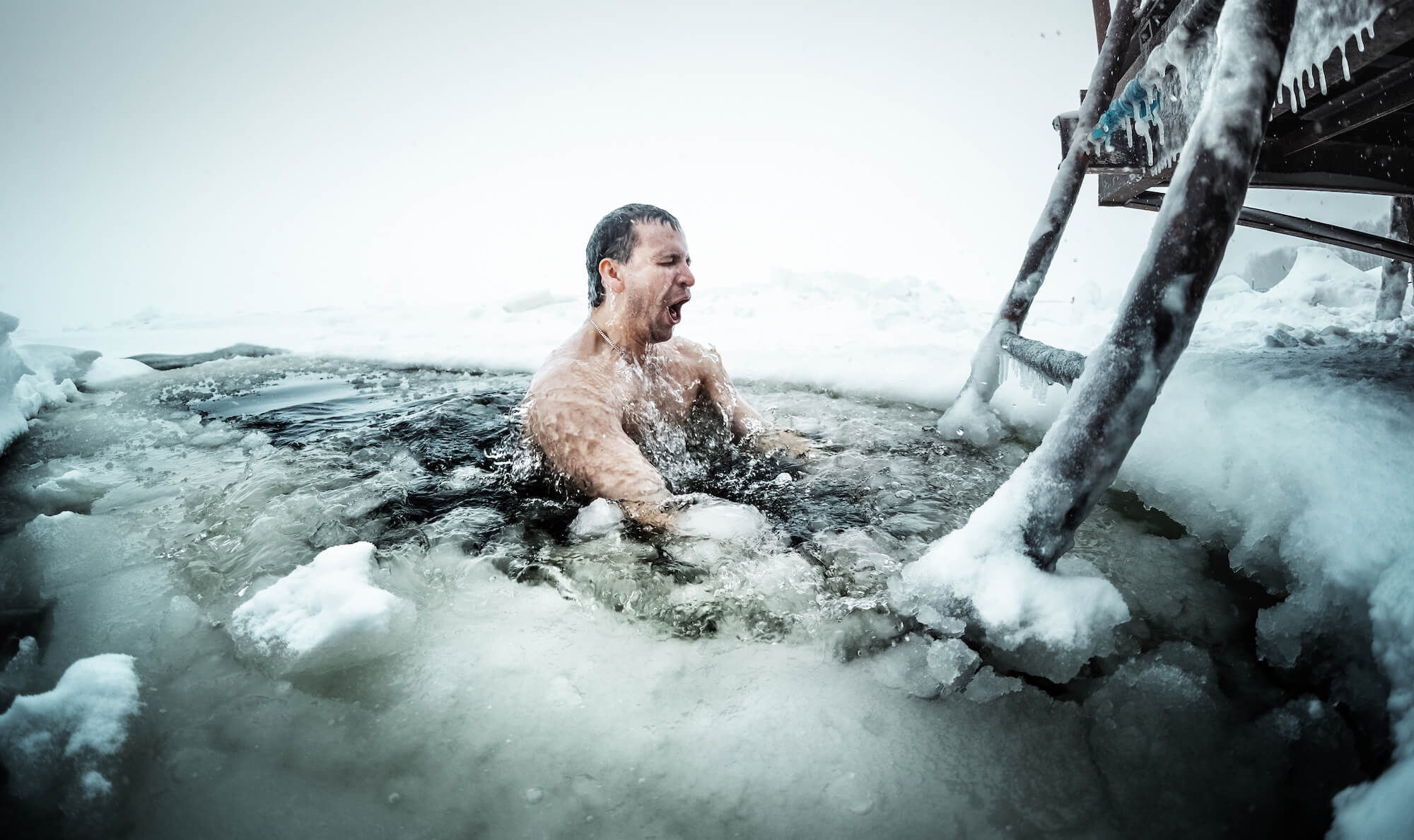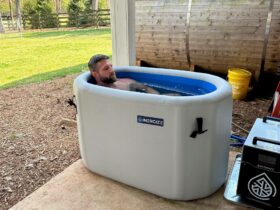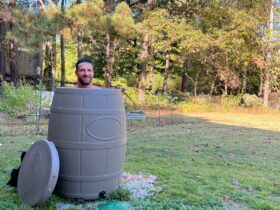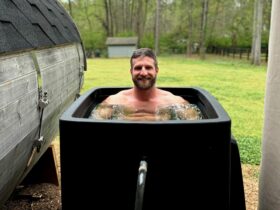Cold water immersion, which is usually referred to as either ice bathing or cold plunging, is an excellent way to reduce inflammation, recover quicker from high-intensity workouts, better manage stress and anxiety, become more resilient and much more.
In this article, I’ll discuss the top 11 potential benefits of ice bathing, with links to scientific research that explains the underlying mechanisms of cold water therapy in even greater detail.
My Experience With Ice Bathing/Cold Plunging
I took my first ice bath in 33-degree water at a biohacking conference in Orlando. It was a transformative experience that ultimately led me to make cold plunging a part of my daily wellness routine.
Here is a list of some of the key benefits I’ve personally experienced since I started taking regular ice baths:
- I’ve noticed improvements in my sleep quality, getting more deep and REM sleep.
- My muscles are less sore after intense exercise.
- I manage my emotions better (and feel stressed out less often).
- I’ve become much more comfortable in cold temperatures.
To learn more about how I leverage ice baths and why investing in this Cold Plunge tub has been one of the best decisions I’ve ever made, check out my Cold Plunge review.
Ice Bath Benefits
While the thought of deliberately exposing your entire body to freezing-cold temperatures might sound counter-intuitive, cold exposure (also known as cold therapy) has several scientifically-validated health benefits that include increasing your energy levels, boosting your immune system, and making you more resilient to cold temperatures and other stressors.
1. Increases Energy Levels

Exposing your body to cold temperatures for short periods causes changes in hormone secretion. For example, studies have shown that the secretion of norepinephrine increases during cold exposure. (Norepinephrine is one of the hormones responsible for regulating attention, focus and energy.)
I’ve been experimenting with taking a three-minute ice bath before intense CrossFit workouts. So far, the results have been promising, as I explain further down.
2. Triggers Hormesis and Improves Resilience

As explained in my article listing the key infrared sauna health benefits, exposing yourself to extreme temperatures makes your body more resilient. That’s because the initial shock of heat or cold exposure allows your body to adapt and become stronger through a process called hormesis.
In many ways, your body adapts to frigid temperatures similarly to how it adapts to intense workouts: it’s uncomfortable initially, but as your body adapts, it becomes stronger.
It took me about four or five ice baths until 39-degree water no longer felt terrible. As a result, I’ve been increasing the duration of my cold plunges, and my sensitivity to cold temperatures has decreased (even outside the tub).
3. Speeds Up Physical Recovery

If you watch professional sports events or the annual CrossFit Games, you may have seen athletes take ice baths after or between intense workouts. That’s in part because studies have shown that cold exposure can increase oxygenated blood flow, thus speeding up muscle recovery and reducing delayed onset muscle soreness.
Enabling your body to heal muscle damage quicker can promote muscle growth and lead to a reduced risk for injury.
When you jump into ice-cold water, your central nervous system causes the blood vessels in your extremities to constrict to force the warm blood to your vital organs. As a result, circulation in your arms and legs gets temporarily restricted.
However, once you get out of the cold water, your blood vessels dilate, thus triggering increased blood flow to the muscle tissue in your extremities and skin.
I’ve been combining infrared sauna bathing with ice bathing to amplify those positive effects. Not only does that dramatically increase blood flow, but the constriction and dilation is also a great workout for my blood vessels. If you don’t have an infrared sauna (like the Sunlighten mPulse I use), you can take a hot shower before or after your cold plunge.
I like the combination of an ice bath followed by a hot shower as part of my pre-workout regimen.
Note that you don’t have to be a professional athlete to benefit from ice bathing after workouts. I’m a hobby athlete and fitness enthusiast, but even I appreciate that cold plunging reduces muscle soreness and speeds up recovery.
4. Improves Your Discipline
Making the conscious decision to submerge yourself in cold water requires discipline and mental strength — especially if the temperature outside the tub is in freezing territory.
I got my Cold Plunge tub delivered in November 2021 — just as temperatures started dropping in Georgia — and we had several days in the low 30s at the time.
Let me tell you this: it’s a pure mind game to strip down to your underwear (or bathing suit) in freezing temperatures, knowing that you’re about to feel even colder as you enter the tub. It’s brutal.
The good news is that if you manage to overcome your fear and hesitation, you’ll be mentally stronger from knowing that you have what it takes to succeed in even the toughest conditions.
5. Boosts Your Mood
When I emerge from the cold water, I feel like I’ve won another battle against my mind. That feeling of having prevailed yet again sets the tone for the rest of my day and puts me in a better mood.
In addition to that psychological boost, there’s also a biological aspect to cold plunging’s mood-altering benefits: the process triggers the release of endorphins and other neurotransmitters, including norepinephrine.
A study published in 2021 demonstrated that low levels of norepinephrine (NE) are associated with depression and other mental disorders, and concluded that “therapeutic agents which specifically increase NE activity are effective antidepressants, and there is evidence that those acting simultaneously on 5-HT and NE neurotransmission may have an antidepressant action superior to selective serotonin reuptake inhibitors (SSRIs).”
6. Helps You Better Manage Stress
As mentioned above, jumping into a tub filled with cold water stresses your body because it causes the activation of your sympathetic nervous system — the one that triggers the “fight or flight” response.
When I took my first cold plunge, I wanted to get out of there as fast as possible. But because there were other people watching (and recording) me, I felt like I had no choice but to calm down by focusing on my breathing.
To this day, I shift all my attention to controlling my breathing when I get into the tub. By doing so, I enable my body to better respond to my overactive sympathetic nervous system and allow my parasympathetic nervous system — the one responsible for resting and digesting — to get back in control.
Being able to down-regulate your sympathetic nervous system means you’re better equipped to manage stress. Over time, that will likely reflect in your heart rate variability (HRV) — a proxy metric that reflects how balanced your autonomic nervous system is.
To learn more about the significance of heart rate variability, you can read my article outlining the biohacks I’ve used to improve my HRV.
7. Improves Your Sleep

Many people have trouble falling asleep (or going back to sleep if they wake up in the middle of the night) as a result of elevated cortisol levels caused by stress.
By learning how to better manage stress (as discussed above), you also get better at relaxing. And being in a relaxed state of mind, especially before bedtime, increases your chances of falling asleep quickly and staying asleep.
Since I began leveraging ice bathing, I’ve noticed a dramatic improvement in an important sleep metric that most people don’t pay much attention to: wake after sleep onset (WASO), which is the time I spend awake after falling asleep.
My WASO used to be in the 45 to 60-minute range, but it has decreased to between 18 and 35 minutes. As a result, my sleep has become much more efficient because I spend less time awake in bed.
8. Helps Burn Fat and Improve Insulin Sensitivity
Exposing your body to cold water activates your brown adipose tissue, also known as brown fat (BAT). This energy-consuming tissue can upregulate your metabolism, clear blood glucose and increase insulin sensitivity, as outlined in this study.
Researchers have also discovered that intense shivering (e.g., after prolonged cold exposure) increases dependence on muscle glycogen. While it’s counter-productive for athletic performance if that happens right before a competition, it’s good news if you’re trying to improve your insulin sensitivity.
As a result, cold plunging can be an excellent tool for weight loss if combined with a healthy lifestyle that includes an appropriate diet, quality sleep and regular exercise.
9. Boosts Your Immune System

Exposing your whole body to cold water increases the plasma concentration of glutathione. This antioxidant plays a key role in the proper function of t-cell lymphocytes. Additionally, glutathione activates your natural killer (NK) cells.
But that’s not all. Scientists in Italy have discovered that cold water swimming induces a significant variation in the blood cell fraction composition. Specifically, the researchers observed a significant increase in red blood cells, white blood cells (neutrophil granulocytes, lymphocytes and monocytes) and platelet count.
As a result, ice bathing is one way to boost your immune system and better equip it to fight pathogens, including viruses and bacteria.
10. Offers Neurocognitive Benefits

Observational studies on hibernating animals have shown that cold shock proteins, such as those triggered during an ice bath, reinvigorate and replace synapses in the brain that were lost during extended periods of sleep (i.e., hibernation).
Scientists have discovered cold shock proteins which prevent cell death in mice that suffer from neurodegenerative diseases. Considering that the same cold shock proteins that protect the brains of mice also have neuroprotective properties in humans, researchers believe that they can be used to prevent or treat neurological diseases, such as dementia or Alzheimer’s.
11. Improves Your Cardiovascular Health
Cold water immersion causes a constriction of your blood vessels, which leads to a temporary increase in blood pressure and reduced blood flow to your extremities, but increased blood flow to your vital organs (including your heart).
Once you get out of the cold water and start warming up, your blood vessels dilate and blood flow to your extremities increases. All that back and forth between constriction and dilation is like a workout for your blood vessels, which helps improve cardiovascular health.
If you’ve been diagnosed with high blood pressure or take blood pressure medication, I’d recommend consulting a knowledgeable healthcare professional before making cold plunging a part of your wellness routine.
Ice Bathing vs. Cold Plunging
You may have noticed that I use the terms “cold plunging” and “ice bathing” interchangeably throughout this article. However, since they might not have the same meaning to everyone, let’s define them.
As far as I’m concerned, cold plunging is an umbrella term used to describe the submersion of your body in cold water. That could mean 32-degree water or 60-degree water — or anything in between. On the other hand, ice bathing typically refers to submerging yourself in water that’s cold enough for ice to form (around 32 to 33 degrees Fahrenheit).
In general, I’d argue that the colder the water is, the more benefit you get. However, it all depends on your tolerance level. If you’ve never taken an ice bath or cold plunge, my recommendation is to start with a temperature that’s uncomfortable but safe.
So if you’re sensitive to cold temperatures and have never taken a plunge before, setting the water temperature to 55 degrees is a good start. However, if you’re mentally strong and have experience with exposing your body to extreme stressors, 33-degree water is entirely doable.
It’s also worth noting that you’ll likely get more benefits from staying three minutes in 50-degree water than 20 seconds in 33-degree water (because it takes time for the body to respond to the colder water by constricting blood vessels and releasing cold shock proteins).
Additionally, you likely won’t be able to down-regulate your sympathetic nervous system (i.e., via breathing exercises) in 20 seconds. So cutting short your time in the cold water will also reduce the benefits you get.
As far as I’m concerned, seeing ice floating next to you in the water looks cool (no pun intended), but it doesn’t necessarily provide more benefits than sitting in a cold bath that’s a few degrees above the freezing point.
Based on my experience with cold water exposure, there is certainly a difference between the cold water coming out of your tap (or shower) and the chilled water inside of an ice bath or cold plunge tub. However, once you get into freezing territory (below 40 degrees), a few degrees up or down becomes somewhat irrelevant.
Of course, your perception of cold plays a major role here. If you’re super sensitive to cold water, a few degrees less might make an impact on the benefits you garner (especially as far as improving your mental strength is concerned).
The Cold Plunge I have at home chills the water to 39 degrees and it’s plenty cold to reap all of the benefits I discussed above.
How I Leverage Ice Bathing
I jump into my Cold Plunge several times a week, and usually stay submerged in the cold water for three to four minutes (and sometimes longer).
Based on my research, you’ll reap most of the benefits after about two minutes of cold exposure, but I’ve gotten so used to it that I often stay in a bit longer.
I take most of my ice baths whenever doing so is convenient. But sometimes I strategically plan them to achieve specific benefits.
Below are a few examples of that.
- Early morning plunge. If I had a bad night and don’t feel super energetic, I just jump into my cold plunge to get a jolt of energy that lasts several hours.
- Pre-workout plunge. Sometimes I jump into the cold plunge, followed by a hot shower, to get some blood pumping before an intense workout — especially strength training sessions.
- Post-workout plunge. If I have sore muscles after a hard workout, I jump into my cold plunge to speed up my recovery as part of my post-exercise routine.
- Afternoon plunge. If I’m super stressed because of work, the kids, or a combination of both, I jump into the cold plunge, followed by a 30-minute session in my Sunlighten mPulse infrared sauna to relax and downregulate my sympathetic nervous system. Additionally, I leverage random cold plunges on active recovery days.
- Evening plunge. I’ve noticed that plunging before bedtime helps me fall asleep quicker and it also improves the quality of my sleep.
I’ve also experimented with longer plunges (up to 12 minutes) to see how they would impact my body. What I’ve noticed during these tests is that every time I spend an extended period in freezing cold water, my heart rate variability (HRV) increases and my resting heart rate decreases during sleep (as measured by my WHOOP Strap).
As I explained in my article about ways to increase your HRV, a high HRV (as compared to your baseline) is an indication that your body is recovering well from stressors of the previous days.
Five Common Ice Bathing Mistakes

While ice bathing is generally safe, there are a handful of mistakes you should avoid if you’ve never done it before.
- Starting too cold. Don’t jump into a frozen lake if you’ve never experienced cold water immersion before. Instead, start somewhere between 50-60 degrees and gradually reduce the water temperature. All-in-one cold plunges allow you to dial in the exact temperature you want so you can get used to the cold water over the course of a few days or weeks.
- Staying in for too long. The sweet spot for ice bathing is somewhere between two and five minutes. Stay in any longer and the benefits diminish. If you stay in for too long, your body temperature may drop too low and you could suffer from hypothermia. As a rule of thumb, if you start shivering it’s probably time to get out.
- Lack of consistency. You get the most benefits from ice bathing if you do it consistently — especially in the beginning, when you’re trying to make it a habit.
- Breathing too fast. Many people hyperventilate when they get into an ice bath because of their overactive sympathetic nervous system. Instead of breathing fast, focus all of your energy on slowing down your breathing. I usually take eight breaths during my three-minute plunges, and I even hold my breath at the end of each exhale for several seconds.
- Not submerging your entire body. You get the most benefits from ice bathing when you submerge as much of your body as possible. In other words, try to submerge yourself up to your jawline to get the vagus nerve in your neck exposed to the cold water. If you’re a pro, you can even submerge your head in the water, or at least splash some of the cold water on your face to trigger a cold shock response.
To be perfectly honest, I’ve broken the first two rules several times (but on purpose). My first ice bath was in 33-degree water, and I stayed in the tub for 2.5 minutes. Since then, I’ve done plunges that lasted between 8 and 12 minutes because I felt comfortable, because I wanted to beat my buddy’s record, or because I wanted to record my entire Cold Plunge review while sitting in cold water.
While not all of those longer ice baths were based on smart decision-making, I want to emphasize that I’ve never endangered myself. In other words, I always got out of the tub before I started to shiver or before my extremities became numb.
Tips to Make Your First Ice Bath a Success
If you’ve stumbled across this article in preparation for your first ice bath or cold plunge, here are a couple of tips that can help you make it a success instead of a traumatic experience.
In a nutshell, I’d recommend avoiding the five mistakes I outlined above.
Start with water that’s between 50 and 60 degrees. Once you’re ready for your plunge, don’t hesitate — get into the tub with both feet and immediately sit down. Immerse your entire body in water, lie back, and then relax.
The only thing you should be focusing on is slowing down your breathing. If you find it difficult to slow down your respiratory rate, hold your breath at the next inhale and don’t breathe at all for a few seconds.
I also recommend not looking at the clock all the time. Instead, either set yourself a timer or listen to a song on your phone. Once the song is over, you can get out.
Regardless of how your first experience is, do it again the next day. My brother-in-law had a mild panic attack during his first plunge (I made him jump into 39-degree water). He lasted for 40 seconds before he had to get out. The next day, he stayed in for a full minute (sans the panic attack). And on the third day, he stayed in the water for over two minutes.
Be consistent and I promise you’ll get used to it!
Common Questions About Ice Bathing

The easiest way to get your feet wet (pun intended) with ice bathing/cold plunging is to start taking cold showers. While the temperature of cold tap water typically isn’t low enough to produce the health benefits outlined in this article, it will help your body get used to cold water exposure and make it easier to handle your first few experiences with ice cold water when the time comes.
Many spas, sports clubs and wellness centers offer ice baths for on-demand use, but it’s important to keep in mind that most of the benefits that come from cold plunging require consistent use.
Given that, if you’re serious about making cold water exposure a part of your wellness regimen, it’s usually easier and more cost-effective to get your own ice bath.
There are many different types of options on the market. My primary tub is the Cold Plunge, because it offers the best balance of convenience, effectiveness and safety that I have found.
If the Cold Plunge is out of your price range, a less expensive option is the Ice Barrel, which serves the same purpose but requires more preparation (e.g., you have to manually fill it up with ice) and maintenance (because it doesn’t have a filtration system). And if you need something that’s portable, TheraFrost is a high-quality inflatable ice bath.
You can learn more about each of these options at the links above or in my Cold Plunge review, Ice Barrel review and TheraFrost review.
Lastly, you can also make your own ice bath out of something like an old wine barrel, though this obviously requires a degree of DIY skill.
Based on the scientific research I’ve read and my personal experience with ice baths and cryotherapy chambers, I’d say that both cold therapy techniques have health benefits. However, I consider cold plunging to be more effective, as I outlined in my Cold Plunge review. You can also learn more in my dedicated article on ice baths vs. cryotherapy.
Cold water immersion is an integral part of the Wim Hof method, which revolves around deliberate cold exposure and also includes breathing exercises that are a powerful tool for influencing your nervous system.
If you’re new to intentional breathing, I highly recommend checking out the Othership app, which I’ve been using for several months to learn and discover new breathing techniques. You can see one of those techniques — which I recently used in combination with cold plunging — in action on my Instagram account
Contrast therapy is a series of brief, repeated immersions in water, alternating between warm and cold temperatures to help speed up recovery after intense workouts. You can mimic contrast therapy by combining sauna and ice bath sessions. I regularly combine sauna bathing with cold plunging, followed by a hot shower.
Ice baths are generally safe if you’re healthy and don’t have any cardiovascular issues. If you do have any preexisting conditions, I recommend consulting with a knowledgeable healthcare professional first. Additionally, I recommend having a partner or friend close by when you plunge into cold water so they can assist you in case you panic or start feeling dizzy.
Both my wife and her brother got overwhelmed and went into full fight or flight mode the first time they submerged their bodies in ice cold water, and I had to help them get out of the tub. That happened because I didn’t follow my own advice and had them start with near-freezing water.
If you stay in freezing cold water for too long, you may suffer from frostbite. That’s why I like to plunge in cold water that’s a few degrees above the freezing point.
Yes, you certainly can get hypothermia by staying in cold water for too long. To reduce the risk of hypothermia, listen to your body and get out of the water when you start shivering. ( Shivering is one of the first signs that your body has had enough).
Yes! Exposing yourself to ice cold water makes you burn fat because it increases your metabolic rate and energy expenditure (to keep you warm).
Additionally, ice baths trigger the activation and recruitment of brown adipose tissue to keep you warm. As you might know, brown fat (as opposed to white fat) is considered beneficial because it helps the body convert energy into heat. It’s the same type of fat babies have to keep them warm once they’re outside of the womb.
Unlike hot water, cold water does not strip away the protective oily layer of your skin. Additionally, cold water temporarily restricts blood flow and tightens pores, which can give the skin a more toned complexion.
If you suffer from eczema or similar skin conditions, I recommend limiting your hot water exposure for the same reason; instead, embrace cold showers and limit your water exposure to less than five minutes.
While many people claim that ice bathing, cold plunging and even cold showers can help lower your blood pressure (because it can lower stress and improve circulation), I don’t think that’s the case. In fact, cold water exposure causes your blood vessels to constrict, thus temporarily increasing blood pressure.
On the other hand, hot showers and sauna bathing can lower blood pressure because it causes blood vessels to dilate.
Early research suggests that regular ice bathing might help with the treatment of certain neuro-degenerative diseases, such as Alzheimer’s. Additionally, cold plunging can help you better manage stress and anxiety because it teaches you how to counter the fight or flight response you likely experience while being submerged in ice water.
I’ve leveraged breathing techniques, including box breathing, to slow down my respiratory rate and help down-regulate my sympathetic nervous system (the same one that’s overactive when you’re anxious or suffering from an anxiety attack).
Contrary to what one might think, swimming in freezing cold water is much harder than staying still in an ice barrel or a cold plunge tub. That’s because when you’re still, the water closest to your skin warms up ever so slightly, creating an invisible barrier. If you swim or move, you disrupt that barrier, making the water feel even colder.
Some of my favorite resources when it comes to discovering new benefits of cold plunging and sauna therapy include Dr. Tracy Zaslow from Cedars-Sinai, Dr. Susanna Soberg (author of Winter Swimming) and Dr. Andrew Huberman.
In fact, Dr. Huberman is one of my favorite resources when it comes to all things biohacking. Not only does he have vast expertise in the areas of cold plunging, sauna bathing and other biohacking tools, but he is one of the few people who can translate complex topics into easy-to-understand and actionable information.
The Benefits of Ice Baths: Summary & Final Thoughts
Are ice baths good for you? The short answer is yes. Ice baths work and can have a substantial impact on your overall well-being. I’ve personally experienced many of the benefits detailed in this article, including improved recovery, pain relief, better sleep and more resilience. I’ve also become mentally stronger and better at managing stress.
So I encourage you to give ice baths or cold plunges a try. It does take some getting used to — it took six plunges for me to tamp down that initial fight or flight response — but it’s totally worth it, and I’m glad I decided to give it a try at that biohacking conference in 2021.

I’m a healthy living and technology enthusiast.
On this blog, I share in-depth product reviews, actionable information and solutions to complex problems in plain and easy-to-understand language.
Medical Disclaimer
The information shared on this blog is for educational purposes only, is not a substitute for the advice of medical doctors or registered dieticians (which we are not) and should not be used to prevent, diagnose, or treat any condition. Consult with a physician before starting a fitness regimen, adding supplements to your diet, or making other changes that may affect your medications, treatment plan or overall health. MichaelKummer.com and its owner MK Media Group, LLC are not liable for how you use and implement the information shared here, which is based on the opinions of the authors formed after engaging in personal use and research. We recommend products, services, or programs and are sometimes compensated for doing so as affiliates. Please read our Terms and Conditions for further information, including our privacy policy.
Source link: https://michaelkummer.com/health/ice-bath-benefits/ by Michael Kummer at michaelkummer.com















